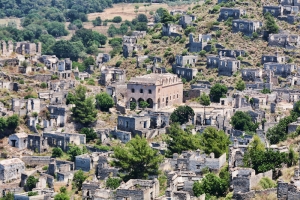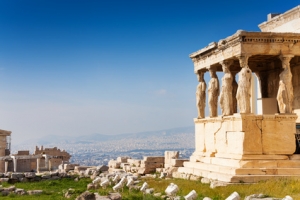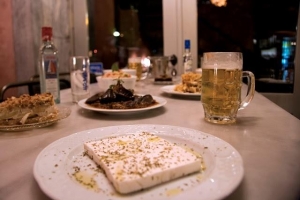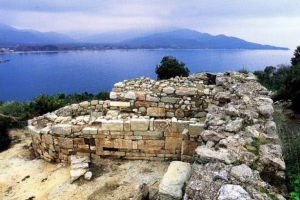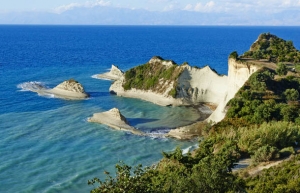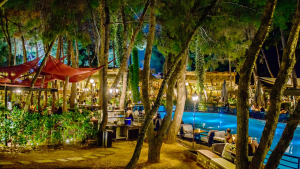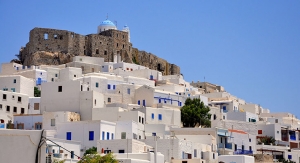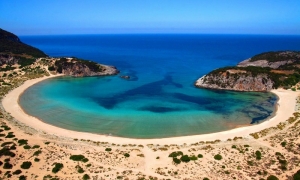SERVICES
XpatAthens
Thursday, 09 June 2016 07:00
Filmmaker Documents Greek Ghost Town Of Levissi
Dating back 5,000 years, the Greek Orthodox town of Levissi, once known as Kayakov, was a village of 10,000 people. However, in 1922, the village went through an ‘ethnic cleanse’ and the people were forced to leave their land and heritage. Now, American filmmaker Joerg Schodl has documented what is left of Levissi in his documentary ‘Ghosts of Levissi.
Schodl tells the tale of the small Greek community in Asia Minor that was torn apart during the final days of the Ottoman Empire. It focuses on the disappearance of the population practically overnight thanks to campaigns, designed to scare Greeks from Levissi and nearby Macri (known as Fethiye), included offensives by Turks.
Since then, the homes have remained vacant, left to decay after being further damaged by a huge earthquake in 1957. The land, however, has been used for summer festivals, but the plan to lease the area and auction it off for commercial interests are causing an uproar among Turks and Greeks with roots to Levissi.
Schodl had the help of members from the Greek community in Melbourne, Adelaide, Sydney, Perth, and Brisbane and he was able to find thirteen descendants of Levissi families. More descendants were found in Toronto, Rhodes, London, Athens and Istanbul.
To read this article in full, please visit: Greek Reporter
See the Ghosts of Levissi trailer here:
To read this article in full, please visit: Greek Reporter
See the Ghosts of Levissi trailer here:
Published in
Greece In The News
Tagged under
Monday, 06 June 2016 07:00
Miracle In Athens As Greek Tourism Numbers Keep Growing
For an economy stuck in depression-era recession, dependent on emergency bails, and seemingly locked in a perpetual fiscal vice, tourism is vital. A record 23.5 million holidaymakers visited Greece in 2015 – generating €14.2bn in direct receipts, or 24% of gross domestic product.
“It’s a miracle, what’s been happening in Athens,” Greece’s tourism chief, Andreas Andreadis, told the Observer. “The tourist industry in Greece grew two to three times faster than in Spain, Portugal, Italy or France last year. This year we expect around 4.5 million visitors in Athens alone.”
It’s been a busy winter in downtown Athens, where scaffolding, tarpaulins and dust have been symbols of hope: a mini construction boom heralding a tourist renaissance. Nine hotels are being built or restored around the city centre.
This year, the Greek Tourism Confederation is predicting the number of visitors could reach 25 million and 27.5 million if you count the cruise ship passengers. Economic recovery depends on the tourism sector to a great degree.
Much of the upsurge is linked to Greece’s safety record. Tourists are staying away from resort in Egypt, Tunisia, Turkey and elsewhere in the wake of high-profile attacks.
Tourism provides one in five jobs in Greece, at a time when unemployment in the nation has hovered stubbornly around 25%. Youth unemployment stands at an astonishing 67%.
“It’s going to be a challenge but our hope is that we will see an improvement on record numbers again,” said Yiannis Retsos, president of the Hellenic Federation of Hoteliers. “Tourism is all about positive psychology and Greece is a safe place in the south-east Mediterranean region.”
To read this article in full, please visit: The Guardian
Published in
Local News
Tagged under
Thursday, 02 June 2016 07:00
Top Things To Eat And Drink In Athens
Travel blogger and author Rebecca Hall, shares her advice on the best dishes and drinks in Athens and the local spots to find them! Here are just a few:
1. Koulouri
This tasty snack is a simple ring of bread sprinkled with sesame seeds or cheese and olives and is sold from koulouri stands all over the city.
Where to Get Koulouri: To koulouri tou Psyri is the bakery that supplies the majority of stands in the Athens area, and it is located in the Psyri neighborhood of Athens, near Monastiraki.
2. Souvlaki
The Greek version of fast food, it’s actually quite healthy. Souvlaki (loosely translated “little skewer”) is cubes of grilled pork or lamb on a stick. Most often it is served with tomato, onion, parsley, tzatziki and fries wrapped in pita bread.
Where to Get Souvlaki: The locals tend to go to Kosta’s, operating since 1950 and located just off Mitropoleos Street near Syntagma Square.
3. Greek Coffee
Ground coffee beans and cold water are slowly brought to a boil in a small pot called a briki with your desired amount of sugar . Then the sweetened coffee is poured into your cup. Like everything else in Greece, it’s designed to be enjoyed slowly.
Where to Find Greek Coffee: Greek coffee can be ordered in any café, but the best non-touristy places in central Athens are located in Iroon Square in the neighborhood of Psiri, near Monasteraki.
To read this article in full, please visit: On Board
To read this article in full, please visit: On Board
Published in
Greek Food & Diet
Tagged under
Thursday, 02 June 2016 07:00
Greek Archaeologist Claims He Found Aristotle’s Tomb At Stagira
A Greek archaeologist, who has been excavating Ancient Stagira in central Macedonia for the last 20 years, has claimed he found the tomb of Aristotle. At a conference in Thessaloniki to commemorate the 2,400th anniversary of Aristotle’s birth, the archaeologist, Konstantinos Sismanidis, said he was almost certain that what he found was Aristotle’s tomb.
Even though Sismanidis and his team have no definitive proof that what they found is Aristotle’s tomb, there are strong characteristics that led them to believe this was in fact the tomb. The characteristics include the location and panoramic view, its position at the center of a square marble floor, and the time of its construction, which started at the beginning of the Hellenistic period. The tomb, according to Sismanidis, was built in honor of Aristotle after his death in 322 B.C.
In addition to finding the tomb, Sismanidis and his team of archaeologists have also found the altar referred to in ancient texts and the road that leads to the tomb.
Another excavation that took place in 2014 in Amphipolis, northern Greece, led to the discovery of the largest ancient tomb ever found in Greece. There was speculation that the tomb belonged to Alexander the Great, Aristotle’s most famous student, but later evidence showed that the tomb had probably been built for a close companion of the king and conqueror.
To read this article in full, please visit: NY Times
Published in
Greece In The News
Tagged under
Tuesday, 31 May 2016 07:00
Two Athens Eateries Among Best Places To ‘Eat At Before You Die’
The popular news and media source Buzzfeed recently released their list of ’31 Places Around The World You Should Eat At Before You Die,’ and two of Athens’ restaurants made the list! The compilation includes a variety of locations and culinary offerings that certainly do not disappoint, as recommended by a cultured group of globetrotters.
One of these globetrotters is Jess Brammar, the senior broadcast journalist on the BBC’s “Newsnight” program. She focused her attention on an Exarchia eatery that provides a spectacular setting of central Athens. According to Brammar, at Ama Laxei the food you will encounter is nothing short of amazing. She describes it as “traditional Greek with a modern twist”. Full of salads and large plates to share, Ama Laxei provides an ideal dinner for larger parties and socialites.
Ama Laxei: Kallidromiou 69, 210 384 5978
Ama Laxei: Kallidromiou 69, 210 384 5978
Athens scores another spot on the list with one of its notable restaurants Seychelles, located in the neighborhood of Metaxourgeio. Jon Henley, a feature writer for the popular news and media company Guardian, dines at this casual hangout and gives and gives credit to its authentically Greek, yet satisfyingly inventive cuisine.
Seychelles: 49 Kerameikou Street, 211 183 4789
Seychelles: 49 Kerameikou Street, 211 183 4789
Reviewers managed to hit a wide variety of cities that takes readers on a trip across the globe. The list highlights Umm Hagar, found in the center of Cairo, Egypt, Armand’s Bistro in Cambodia, Vijay’s in the northwest of London, and Don Alfonso overlooking the Amalfi coast and Sorrento.
To see the full list of Places To Eat At Before You Die, please visit: Buzzfeed
Published in
Restaurants In Athens
Tagged under
Tuesday, 31 May 2016 07:00
How British Expats Can Vote In The UK EU Referendum
The UK's EU referendum will take place on 23 June with a decision of whether or not the UK will stay in the European Union.
To vote 'yes' or 'no' is important for many people, including British citizens living overseas. Here are just a few important facts about the referendum and information on how to vote!
To vote 'yes' or 'no' is important for many people, including British citizens living overseas. Here are just a few important facts about the referendum and information on how to vote!
- An estimated 5.6 million British citizens overseas
- Since 1985, anyone over 18 who has lived abroad for less than 15 years is eligible to vote in British parliamentary and European elections
- British citizens living abroad for more than 15 years are automatically disenfranchised.
Prime Minister David Cameron promised to hold one if he won the 2015 general election, in response to growing calls from his own Conservative MPs and the UK Independence Party (UKIP), who argued that Britain had not had a say since 1975, when it voted to stay in the EU in a referendum. The EU has changed a lot since then, gaining more control over our daily lives, they argued. Mr Cameron said: "It is time for the British people to have their say. It is time to settle this European question in British politics."
What does Brexit mean?
It is a word that has become used as a shorthand way of saying the UK leaving the EU - merging the words Britain and exit to get Brexit, in a same way as a Greek exit from the EU was dubbed Grexit in the past.
Who will be able to vote?
British, Irish and Commonwealth citizens over 18 who are resident in the UK, along with UK nationals living abroad who have been on the electoral register in the UK in the past 15 years. Members of the House of Lords and Commonwealth citizens in Gibraltar will also be eligible, unlike in a general election. Citizens from EU countries - apart from Ireland, Malta and Cyprus - will not get a vote.
I am a UK national but I live abroad. Can I vote in the referendum on EU membership this coming June?
Yes, but only if you have not lived abroad for more than 15 years.
What arrangements do I need to make so that I can vote?
All the details can be found here. You must be on the UK electoral roll to be able to register. You will need your national insurance number and passport.
For more information about the UK's EU referendum, please visit: BBC News
For more information on how to vote as a British expat, please visit: Euro News
For more information about the UK's EU referendum, please visit: BBC News
For more information on how to vote as a British expat, please visit: Euro News
Published in
Local News
Tagged under
Monday, 30 May 2016 07:00
Idyllic Corfu Village Steals The Limelight In New BBC Drama
Corfu, a stunning Greek island, is featured in a new 6-part BBC drama series being aired in the UK. The show is called Durrells and is based on Gerald Durrell’s trilogy of Corfu memories.
Keeley Hawes, also seen in Spooks and Line of Duty, is the leading actress in this drama series. The best beaches like Palaiokastrisa, Agios Georgias, and Achilles, as well as Danilia, a traditional Corfu village, are all captured on screen.
The village of Danilia is owned by one of Greece’s most luxurious hotel groups and hopes Durrells will inspire people to go on holidays in Corfu. They are even offering hotel packages to celebrate the new drama, which will include a complimentary private tour of the village.
Corfu has also been the location for James Bonds’ For Your Eyes Only.
To view this article in full, please visit: Sunday Express
Published in
Greece In The News
Tagged under
Friday, 02 July 2021 07:00
Great Bars To Visit In Athens' Northern Suburbs
From Halandri to Kifissia, the northern suburbs of Athens feel almost a world away from the trademark chaos of downtown areas. Although quieter (and greener!) compared to the center, one can find a number of fun activities and trendy hangouts there.
Here are some cool places to enjoy a leisurely drink when visiting one of Athens' northern neighborhoods.
The Dalliance House
Located in a wonderful neoclassical house in Kifissia, the Dalliance House has wonderful deco, reminding you of a stylish, cozy living room. It is open from 10 in the morning until late at night for an all-day experience. During the afternoon, the restaurant offers Mediterranean recipes and when it's time for a drink, you will find tasteful cocktails and a large variety of malts, beers, and wines.
Address: Kyriazi 19, Kifissia
Telephone: 210 6230775
Here are some cool places to enjoy a leisurely drink when visiting one of Athens' northern neighborhoods.
The Dalliance House
Located in a wonderful neoclassical house in Kifissia, the Dalliance House has wonderful deco, reminding you of a stylish, cozy living room. It is open from 10 in the morning until late at night for an all-day experience. During the afternoon, the restaurant offers Mediterranean recipes and when it's time for a drink, you will find tasteful cocktails and a large variety of malts, beers, and wines.
Address: Kyriazi 19, Kifissia
Telephone: 210 6230775
Paliatsos
The Paliatsos Cafe/Wine Bar has been a good reason to visit Penteli over the past few years. It is an elegant and warm place that has a vintage style with old furniture and comfortable sofas to unwind and enjoy your coffee while listening to relaxing melodies.
Address: Vasileos Georgiou B' & Souvaliotou, Penteli
Telephone: 210 8100889
Piu Verde
This is a classic and favorite spot inside the Alsos of Papagou. With high pine trees, a lovely water fountain, and an artificial lake, Piu Verde gives you the impression of a house in the woods. The relaxing atmosphere and the breathtaking scenery are just what you need to enjoy your coffee, meal, or drink. The bar offers excellent cocktails and the DJ's soundtracks enhance the lovely ambiance.
Address: Strat. Al. Papagou & 8th Merarxias, Alsos Papagou
Telephone: 210 6546185
33m2
We would say this bar is a trademark of Vrilission square. It has a friendly atmosphere and a relaxing style. In the morning, the bar serves fresh ground coffee, while, at night, the colorful cocktails hold the customers' interest. One of the bar's highlights is the wine list, which includes labels from Greek and foreign vineyards.
Address: Plateia Analipseos 4, Vrilissi
Telephone: 2106821033
Mr Peacock
The Paliatsos Cafe/Wine Bar has been a good reason to visit Penteli over the past few years. It is an elegant and warm place that has a vintage style with old furniture and comfortable sofas to unwind and enjoy your coffee while listening to relaxing melodies.
Address: Vasileos Georgiou B' & Souvaliotou, Penteli
Telephone: 210 8100889
Piu Verde
This is a classic and favorite spot inside the Alsos of Papagou. With high pine trees, a lovely water fountain, and an artificial lake, Piu Verde gives you the impression of a house in the woods. The relaxing atmosphere and the breathtaking scenery are just what you need to enjoy your coffee, meal, or drink. The bar offers excellent cocktails and the DJ's soundtracks enhance the lovely ambiance.
Address: Strat. Al. Papagou & 8th Merarxias, Alsos Papagou
Telephone: 210 6546185
33m2
We would say this bar is a trademark of Vrilission square. It has a friendly atmosphere and a relaxing style. In the morning, the bar serves fresh ground coffee, while, at night, the colorful cocktails hold the customers' interest. One of the bar's highlights is the wine list, which includes labels from Greek and foreign vineyards.
Address: Plateia Analipseos 4, Vrilissi
Telephone: 2106821033
Mr Peacock
Located in Halandri, Mr Peacock is a big space, with a nice garden, an impressive bar, and stylish décor. The bar serves a wide variety of deliciously refreshing cocktails, like the Peacock Mule with vodka, passion fruit syrup, and mango puree.
Address: Katsoulieri 7, Halandri
Telephone: 21 0680 0390
Address: Katsoulieri 7, Halandri
Telephone: 21 0680 0390
Published in
Pubs, Bars & Cafes
Tagged under
Thursday, 26 May 2016 07:00
Best Low Budget Summer Destinations In Greece
Greece’s busy season is quickly approaching and the word ‘holiday’ comes to a lot minds. The Greek Islands are perfect for a summer holiday, but if you rather not break the bank, here’s a list of the best low budget destinations!
The Small Eastern Cyclades
Great for nature lovers with amazing beaches and it’s not too crowded! These islands have something for everyone with crystal clear water, caves, and even an old pirate haven! The small cyclades include Pano and Kato Koufonissi, Donoussa, Iraklia, and Schinoussa. All have regular ferry connections with Naxos, Amorgos, and Piraeus.
Kythira in the Ionian Islands
Tourism has not reached its peak just yet on this island so its still quiet. Visitors can walk through traditional villages, the medieval castle of Hora, and then enjoy the pristine beaches. No plan is necessary here and it’s best to just explore.
Serifos in the Cyclades
With only 1,400 people living on the island, there’s still plenty to do here! The main attractions are the white Hora and the white chapels among the Venetian castle. The sites to see are the small swimming bays for a swim, the Taxiarches Monastery, the Byzantine Church of the Panagia, the Cyclops cave, and more!
Astypalaia in the Dodecanese
Yet another island with beautiful beaches and clear waters. Also worth a visit here is to see the Venetian castle and the Monastery of Agios Ioannis.
Parga in Epirus
Not as quiet as some of the other islands mentioned, but picturesque nonetheless. The most popular beaches are Platys Gialos tou Valtou and Necromandeio at Acheroussia.
To read this article in full and to see more of the best low budget destinations, please visit: Hip Greece
To read this article in full and to see more of the best low budget destinations, please visit: Hip Greece
Published in
Travel Greece
Tagged under
Thursday, 26 May 2016 07:00
Lonely Planet Names Peloponnese Top European Destination In 2016
Lonely Planet has recently released their 'Best In Europe' list for European destinations you must see in 2016. Coming in at #1 is the Peloponnese in Greece! Here’s what the popular travel website had to say about this must-see European destination!
‘Travellers to Greece tend to flock to the myriad islands or marvel at the iconic Acropolis, but one of the country’s most diverse, vibrant regions is often forgotten: the Peloponnese. It remains an affordable enclave of magnificent ancient sights like Olympia, Mycenae and Mystras, which are scattered across a rich landscape of stone villages, teal seas and snow-capped mountains.
2016 brings the chance to hike the Peloponnese’s new Menalon trail or take a tipple in the Nemean wine region, with its vintages gaining prominence around the globe. You can dive shipwrecks off the Navarino coast or visit the wild and remote Mani, home to ancient stone towers converted into boutique luxury lodgings. Beautiful Nafplio blends contemporary art with atmospheric architecture and classic town squares, ideal for a long, lazy lunch.’
Lonely Planet also says that the Peloponnese is a great place to see traditional Greek life, its history, and beautiful landscapes!
To see this article in full and the rest of the 'Best In Europe' list, please visit: Lonely Planet
To see this article in full and the rest of the 'Best In Europe' list, please visit: Lonely Planet
Published in
Greece In The News
Tagged under

